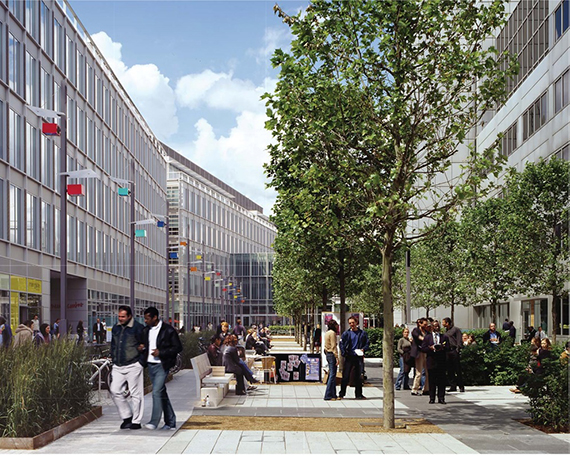With placemaking critical to success, major regeneration schemes across London have designs on the creative community to help establish themselves as the capital’s new cultural quarters

King’s Cross Central, N1
Developer: Argent
Size: 70 acres
Percentage of cultural/creative space: 12%
Cultural focus: Arts and public space. In September 2011, the University of the Arts London moved to the Granary Complex and the development has become known for its creation of new public spaces and 10 squares. Granary Square, which features 1,000 choreographed fountains, opened in June 2012 and has already played host to the musical festivals Traction and Africa Express, as well as The Big Dance. The size of Trafalgar Square, there is capacity for 2,000 people in Granary Square alone and the nearby canal-side steps are often used as an amphitheatre.
Robert Evans, partner at Argent, says: “The cultural elements of the scheme attract people – both residents and commercial occupiers – looking for live, work, play. Young people in particular like the idea of having stuff to do and places to eat and drink just around the corner. Even their workplace – they don’t necessarily want to commute that far. Having culture on the doorstep is what so many people want now.”
Vauxhall Nine Elms Battersea Opportunity Area, SW8
Developer: Various
Size: 481 acres
Percentage of cultural/creative space: TBC
Cultural focus: Anything goes. From grand plans for the Vauxhall Arches to a Damian Hirst gallery, this area is set to become one of London’s biggest new districts and will offer one of the capital’s most extensive cultural quarters. Public spaces are being designed with art and theatre in mind and will be able to support dance performances, events, markets and exhibitions. The Royal College of Art’s Battersea campus has already begun to elevate the area’s creative kudos, and Battersea Power Station’s former boiler house and control room will be cultural venues.
You know a scheme is serious about culture when it hires a dedicated head of design and placemaking – which is exactly what the Battersea Power Station Development Company has done. That man is former Treasury Holdings commercial director David Twohig, who says: “The spaces in between the buildings are as important as the buildings themselves.”
Royal Arsenal Riverside, Woolwich, SE18
Developer: Berkeley Group
Size: 88 acres
Percentage of cultural/creative space: 20%
Cultural focus: Performing arts, to reflect Greenwich’s existing reputation and history in this area – the borough is already home to the Trinity Laban Conservatoire of Music and Dance. It has been mooted that the world-famous Hofesh Schechter contemporary dance company will be taking space within the site’s new cultural district in what will be one of the biggest performing arts centres in the country. The site is also the location of regular music festivals, exhibitions and farmers’ markets.
Karl Whiteman, divisional managing director at Berkeley Homes, says: “We have these great heritage buildings and it makes perfect sense to use them to create a new cultural district in east London. And that cultural offering is not limited to the residents here. We want Royal Arsenal to become a new destination, rather than just a commuter point, by attracting cultural occupiers and creative start-ups.”
BBC Television Centre, White City, W12
Developer: Stanhope
Size: 14 acres
Percentage of cultural/creative space: TBC
Cultural focus: Apart from the rich cultural history and status already built in thanks to the BBC television studios being part of the new site, the redevelopment looks set to become a new Mecca for media start-ups and independent occupiers. The biggest coup so far has been signing Soho House – the private members’ club for the creative industries – as a tenant, cementing the development’s reputation as west London’s creative hub in-waiting.
Pankaj Patel, founding partner of White City masterplanner Patel Taylor, says: “How do you get people to come in? That’s the big question we ask when we design these schemes, because that is what adds to the investment argument – if you can create a destination. We have to make the public spaces between the buildings work even harder to create new districts which will sustain footfall and buzz.”
Soho House chief executive Nick Jones says: ‘The area has a rich tradition of creative talent and the development will provide a worthy addition and a new home from home for our members.”











